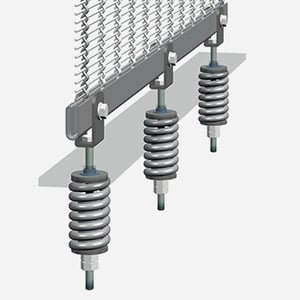Designing Architectural Wire Mesh: What Files Should I Use?
Architectural Mesh - Exterior | Architectural Mesh - Interior
Architectural design, when accompanied by unique and stunning design materials, can be an exciting experience for both the architects and on-lookers. We find that many designers turn to architectural wire mesh as its multi-functional characteristics deliver unexpected visual effects that help create memories.
There are several pieces to the puzzle that you must put in place to ensure a seamless and effective architectural mesh installation. This includes the design files that must be submitted to put the mesh supplier in your shoes and see your vision.
Here at W.S. Tyler, we understand that it can sometimes be challenging to piece the different elements of an architectural wire mesh system together. We strive to use our 20 years of experience to help create an organized design process and ensure you can weave your vision into reality.
To help you make heads or tails of the design files associated with architectural wire mesh, so you are best prepared, the following article will discuss:
- What design files you will have to put together
- The designated purpose of each design file
- What information each file should showcase
- When you should submit your design files
What Design Files Accompany Architectural Wire Mesh?
When working on the architectural mesh design for a project, you will usually be asked to submit two types of digital files. These formats include vector and DWG.
Vector File

Vector files are digital images that feature geometric imagery centralized around mathematical grid points. This allows these images to be stretched or shrunk without losing quality.
DWG File

DWG files are binary files employed when storing information for 2D and 3D architectural designs. Closely related to the CAD file format, architects often turn to DWG files when sketching out their vision.
What Purpose Do These Design Files Serve?
Architectural wire mesh grants you the ability to feature printed imagery to portray specific designs or logos. Now the file for this artwork could never be the full size of how it will be transposed onto architectural mesh panels.
As vector files are driven by mathematics, it is infinitely scalable. In other words, vector files allow manageable design files to be stretched and transferred onto your wire mesh panels without losing quality.
DWG drawing files, on the other hand, are required for us to produce our shop drawings. This is because the DWG files you submit will outline the structure, and we draw in our mesh to generate measurements.
What Information Should These Files Contain?
The three file formats all encompass submitting a structural drawing that provides the ability to portray the architectural wire mesh application in more detail. In other words, they provide a clearer view of the various parameters of the system.
In turn, this allows us to give you a more accurate quote. It's for this reason that, regardless of what file format you submit, your drawing should include everything and anything about the project.
For DWG files, this includes elements such as the height of the building, the width of the opening being covered, and the amount of space between each panel. The drawings should also specify the location of the substructure, the tensioning spots, and where the mesh panels will be mounted in relation to the substructure.
Vector files should include the imagery in its entirety with the correct color scheme and spacing between elements. To that end, the colors you select must fall within either the RAL or Pantone color spectrum.
When Should I Submit My Design Files?
Design files should be submitted as soon as they are complete. This is because we use these files to form our own shop drawings in-house and sometimes have to alter the parameters or dimensions of the mesh panels.
The more information we know upfront, the quicker we will be able to work out these logistics of the mesh system and render a finalized drawing that captures your vision.
Get To Know the Structural Calculations of Your Architectural Mesh System
When designing an architectural wire mesh system, you will eventually be required to submit two types of design files: vector files and DWG files. Vector files should feature any imagery you wish to transfer to your panels, whereas DWG should lay out the details of the structure your mesh will be attached to.
Now, once you submit your design files and we generate the appropriate shop drawings, you will eventually receive structural calculations. It's critical that you can properly interpret these structural calculations as they will determine whether or not the structure can withstand the tension load of the mounted wire mesh panels.
For over 20 years, W.S. Tyler has worked to remove the uncertainties surrounding architectural wire mesh. From first contact to the installation of your wire mesh panels, we take pride in helping architects get to know what they should expect with an architectural wire mesh system.
To gain a better understanding of the structural calculation of your architectural mesh system translates to what can and cannot be done, read the following article:
About Ronnie Brown
Ronnie is the Content Writer for W.S. Tyler and has four years of experience as a professional writer. He strives to expand his knowledge on all things particle analysis and woven wire mesh to leverage his exceptional writing and graphic design skills, creating a one-of-a-kind experience for customers.




